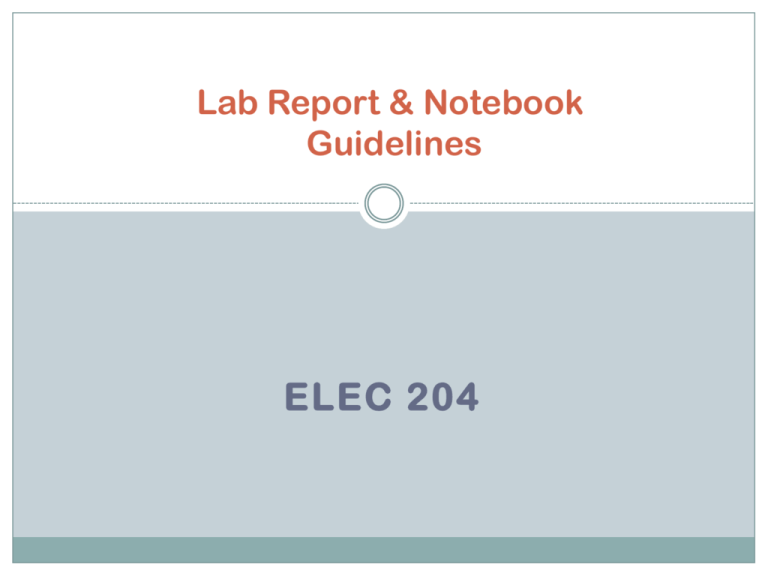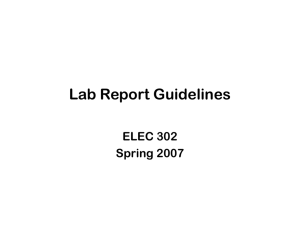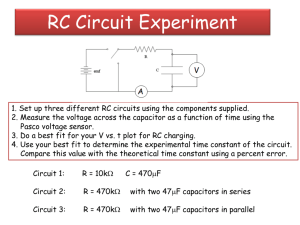Laboratory Report & Notebook Guidelines
advertisement

Lab Report & Notebook Guidelines ELEC 204 Basic Requirements Succinct and clearly written. Sufficient description to enable an engineer familiar with basic electrical measurements to reproduce your results. Printed output from a word processor. Figures may be hand-drawn, if necessary. Proper grammar, punctuation, spelling expected Formatting Typed in 10 or 12 point type formulae typeset using an equation editor Same font and form for all headings. One inch left & right margins Number every page of the report, but don’t show number for cover page. Cite your source as a reference (a number in square brackets, e.g. [1]) A list of references at end of report (IEEE) Tables & Figures Tables and figures must have a title, a number, and a caption (above for table, below for figure). Referenced in the text by title and number Specify unit of measure associated with variable Use table when there is no relation between subsequent datum Required Elements Cover page Purpose of experiment Test configuration Circuit tested Test procedure Measured results/Comparison with theoretical results Conclusion Cover Page ELEC 204-01 Technical Report for Lab Assignment #0 Resistor Combinations in Series Course/section number Assignment number Experiment title Engineer names G. Kirchhoff E.L. Thevenin January 31, 1872 Engineer signatures Date of submission Purpose of Experiment State theoretical principles or concepts that this experiment is trying to prove. May also be to gain experience in using the lab equipment. Test Configuration Block Diagram Instrument Manufacturer/Model Number HP34401A MULTIMETER RESISTOR NETWORK UNDER TEST Circuit Tested Schematic of circuit Reference designators Nominal element values should be given. 1.5K R1 7.5K R2 Test Procedure Enough description that the experiment could be reproduced by anyone familiar with basic electrical measurements. Sequential in narrative style (i.e., no bulleting or numbering) Do not just copy the instruction lists in the lab assignments. Write in third person, past tense, passive voice. First Person We connected the function generator to the input port of the circuit. Second Person We connected the function generator to the input port of the circuit. Connect the function generator to the input port of the circuit. Third Person We connected the function generator to the input port of the circuit. Connect the function generator to the input port of the circuit. The function generator was connected to the input port of the circuit. Measured Results Nominal value is the value expected by looking at the markings on the device. Measured value is read off the test equipment during the experiment. Use tables where appropriate. Deviation from nominal measured nominal %deviation 100% nominal Comparison with Theoretical Measured values versus what would be predicted by a theoretical analysis of the circuit performance, e.g., compare the measured resistance of two resistors connected in series with R1+R2. Express comparison as a %error. measured theoretical %error 100% theoretical Discussion of results in present tense, passive voice Conclusions What theoretical principle or concept did this experiment prove? Within experimental error, this laboratory exercise has demonstrated that the equivalent resistance of two resistors connected in series is equal to the sum of the individual values. Describe how the principle is supported by your findings/data. Conclusions What theoretical principle or concept did this experiment prove? Within experimental error, this laboratory exercise has demonstrated that the equivalent resistance of two resistors connected in series is equal to the sum of the individual values. “I learned a lot” or “it was fun” are not valid conclusions. Typical Grading Form Lab Notebooks Most companies require their engineers to keep notebooks of their work. Effective evidence in patent disputes Chronological account of work helps engineers remember what has been done. Requirements Bound volume. Loose leaf notebooks are not acceptable. All pages must be sequentially numbered. Each side of a sheet is considered a page. The first sheet should be reserved for a table of contents. Label the first page used for a particular experiment with the title of that experiment, and reference the page number in the Table of Contents. Requirements Make all entries in ink. Do not erase entries. To delete information, cross it out with a single line. The date entries were made must appear on every page. Each page must be signed by the engineer taking the data. Requirements No blank numbered pages are permitted. Write “This page intentionally left blank.” if necessary. Any added material, such as PSPICE plot, must be permanently affixed using tape or glue. The material itself must be signed and dated. Summary A lab notebook is not intended to be a publication quality document. It is first and foremost a chronological record of the daily work of an engineer. As such, it can serve as a valuable legal document and guide for others carrying the work forward.






